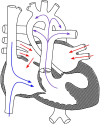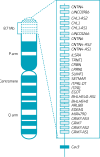First report of hypoplastic left heart syndrome in 3p- syndrome and review of candidate genes
- PMID: 39841745
- PMCID: PMC11748497
- DOI: 10.1590/1984-0462/2025/43/2024133
First report of hypoplastic left heart syndrome in 3p- syndrome and review of candidate genes
Abstract
Objective: 3p deletion syndrome is a rare monosomal disease that encompasses deletions throughout the short arm of chromosome 3. It is often in the distal region (3p25-pter), but variations in breakpoints and a complex clinical manifestation exist, with congenital heart defects being considered rare. We present the first case of hypoplastic left heart syndrome and minor dysmorphic features associated with 3p- syndrome. Furthermore, we aim to establish a gene-phenotype association.
Case description: The diagnosis was made by karyotyping, followed by a literature investigation and in silico bioinformatic analysis about the possible candidate genes associated with congenital heart defects or hypoplastic left heart syndrome in 3p- syndrome. All genes analyzed that could affect heart formation are located in the 3p25.3 region, adjacent to the deleted region in the newborn from our case (3p26). Taking into account the technical limitations of the karyotype and the strength of evidence from each gene evaluated and locus proximity, it is likely that an unidentified partial break in the CAV3 gene occurred.
Comments: We identified an indirect relation between gene CAV3 and hypoplastic left heart syndrome due to its strong association with cardiomyopathies and isolated cardiac defects. Furthermore, the cytogenetic band from our case is new information for the delimitation of a critical cardiac region on 3p syndrome, a discussion that has been ongoing since 1986. Thus, we reinforce the importance of cytogenetic investigation in patients with hypoplastic hearts and dysmorphia, assisting in diagnosis, definition of prognosis, and genetic counseling for the family.
Objetivo:: A síndrome da deleção 3p é uma doença monossômica rara que engloba deleções em todo o braço curto do cromossomo 3. Frequentemente está na região distal (3p25-pter), mas apresenta variações nos pontos de quebra e uma manifestação clínica complexa, cujas cardiopatias congênitas são consideradas raras. Apresentamos aqui o primeiro caso de síndrome do coração esquerdo hipoplásico e características dismórficas menores na síndrome 3p-. Além disso, buscamos estabelecer uma associação gene-fenótipo.
Descrição do caso:: O diagnóstico foi feito por cariótipo e procedeu-se a uma investigação bibliográfica e análise bioinformática in silico sobre os possíveis genes associados a cardiopatias congênitas ou síndrome do coração esquerdo hipoplásico na síndrome da deleção 3p. Todos os genes analisados que poderiam afetar a formação do coração estão localizados na região 3p25.3, adjacente à região deletada no recém-nascido do nosso caso (3p26). Tendo em conta as limitações técnicas do cariótipo, a força da evidência de cada gene avaliado e a proximidade do locus, é provável que tenha ocorrido uma quebra parcial não identificada no gene CAV3.
Comentários:: Identificamos uma relação indireta entre o gene CAV3 e a síndrome do coração hipoplásico esquerdo, em razão da sua forte associação com cardiomiopatias e defeitos cardíacos isolados. Além disso, a banda citogenética do nosso caso é uma informação nova para a delimitação de uma região cardíaca crítica na síndrome 3p, discussão que está em andamento desde 1986. Assim, reforçamos a importância da investigação citogenética em pacientes com coração hipoplásico e dismorfias auxiliando no diagnóstico, definição de prognóstico e aconselhamento genético para a família.
Conflict of interest statement
Figures


Similar articles
-
Hypoplastic left heart syndrome and 21q22.3 deletion.Am J Med Genet A. 2015 Mar;167A(3):579-86. doi: 10.1002/ajmg.a.36914. Epub 2015 Feb 7. Am J Med Genet A. 2015. PMID: 25663264 Review.
-
Molecular cytogenetic characterization of a subtle interstitial del(3)(p25.3p26.2) in a patient with deletion 3p syndrome.Am J Med Genet. 2002 Apr 22;109(2):133-8. doi: 10.1002/ajmg.10323. Am J Med Genet. 2002. PMID: 11977162
-
Pure partial monosomy 3p (3p25.3 → pter): prenatal diagnosis and array comparative genomic hybridization characterization.Taiwan J Obstet Gynecol. 2012 Sep;51(3):435-9. doi: 10.1016/j.tjog.2012.07.022. Taiwan J Obstet Gynecol. 2012. PMID: 23040932
-
Microdeletion on 3p25 in a patient with features of 3p deletion syndrome.Am J Med Genet A. 2012 Oct;158A(10):2583-6. doi: 10.1002/ajmg.a.35559. Epub 2012 Aug 17. Am J Med Genet A. 2012. PMID: 22903836
-
Chromosome r(3)(p25.3q29) in a Patient with Developmental Delay and Congenital Heart Defects: A Case Report and a Brief Literature Review.Cytogenet Genome Res. 2016;148(1):6-13. doi: 10.1159/000445273. Epub 2016 Apr 15. Cytogenet Genome Res. 2016. PMID: 27077748 Review.
References
-
- Maher E, Raymond L, Dikow N, Maitz S. 3p25 deletion [homepage on the Internet] Unique; 2022. [[cited 2024 May 16]]. Available from: https://rarechromo.org/media/information/Chromosome%20%203/3p25deletions... .
-
- Kritzmire SM, Cossu AE. Hypoplastic left heart syndrome NCBI. [[cited 2023 June 19]]. [homepage on the Internet] Available from: https://www.ncbi.nlm.nih.gov/books/NBK554576/
-
- Dionísio MT, Couceiro A, Galhano E, Matos L, Mesquita J, Sousa G, et al. Síndrome do Coração Esquerdo Hipoplásico: 19 anos de diagnóstico pré-natal. Diagn Prenat. 2011;22:2–6. doi: 10.1016/j.diapre.2010.01.003. - DOI
Publication types
MeSH terms
LinkOut - more resources
Full Text Sources
Research Materials

